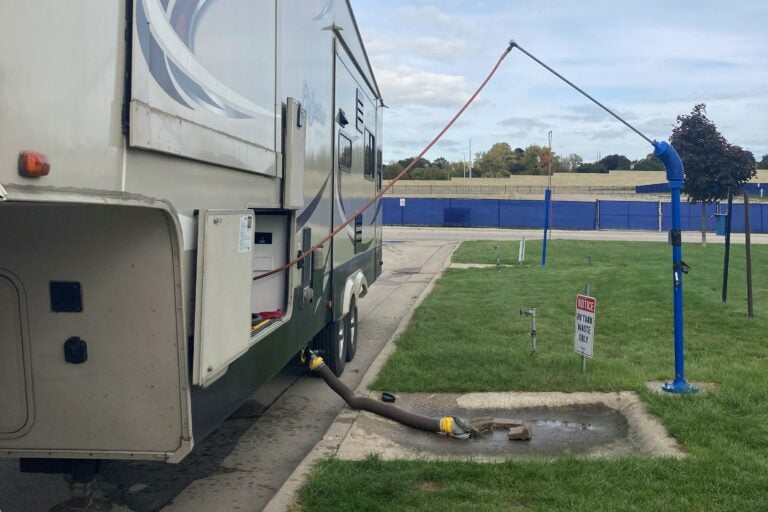This post may contain affiliate links. See our affiliate disclaimer here.
Let’s start with the basics for beginners who need RV water tanks explained. All RVs, fifth wheels and travel trailers have three types of RV holding tanks:
- Gray water
- Black water
- Fresh water
RV black tanks and gray water tanks allow you to use the conveniences of your own kitchen and bathroom while living on the road. However, the use and maintenance of these tanks can be overwhelming for new full-time RVers.
This article provides a comprehensive overview of everything you need to know to keep your tanks clean and functional while living in an RV.
Contents
Black and Gray Water Tanks
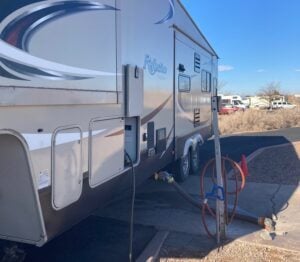

Overview
RV black and gray water tanks hold wastewater from your sinks, shower and toilet. Tank sizes vary by RV, but you will need to empty or “dump” your tanks frequently when you are living in an RV. How often you will need to dump will depend on your water use and the size of your tanks.
When it is Time to Dump your RV Black and Gray Tanks?
Most RVs built within the last 10 years have sensors that tell you how full each holding tank is. The location and style of the monitor varies by RV (the sensor from our Grand Design fifth wheel is pictured below).
It is important to note that these sensors will not work accurately if your RV is not level. When you first start RVing, you should check these sensors everyday (or a few times a day if you are using a significant amount of water) to learn how quickly your tanks are filling. Of course, the sensor will indicate full a bit before the tank is actually at capacity.
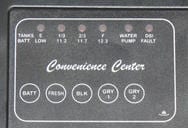

So what if you forget to check your sensors and let the tank overflow? If your gray tank is full, water will stop draining from the sink and/or shower pan and they will continue to fill with water.
If your black tank is full, the same thing happens except it is much nastier. Always go ahead and dump as soon as the sensor indicates “full.” Believe me, you do not want to learn this lesson the hard way.
Where do you Dump your Gray and Black Tanks?
Campgrounds will advertise their sites as “full hook-up” if they have electric, water and sewer connections. If your campsite does not have a sewer connection, you will need to find a dump station.
Many RV parks have a dump station on-site for campers to use. If you are really lucky, your RV park may offer a honey wagon service, where they come to your campsite and dump your tanks into a mobile dump station.
If you are boondocking and need to find a dump station on the road, you can use the AllStays app to find one near your campsite or along your route. Most truck stops will charge 5 to 10 dollars to use their dump station.
How to Dump your Gray and Black RV Holding Tanks
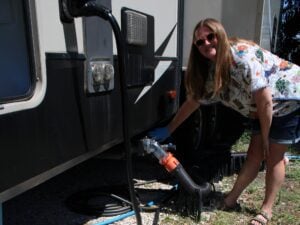

Put on some gloves: While you will not be touching waste, you will be handling hoses that contain waste, so it is best to cover your skin to prevent any nasty incidents.
Hook-up your hose: Connect your hose to the RV drain and the dump station. You will need an elbow connector to ensure the wastewater does not spill while dumping. If you do not have a sewer hose yet, this RhinoFLEX sewer hose kit includes enough hose to reach most dump stations and all the connections you will need.
Empty the black tank: Pull the valve for you black tank and let it run until you no longer hear any water flowing, then close the black tank.
Empty the gray tanks: Pull the valve on your gray tank (or both gray tanks if you have two) and let them empty until you no longer hear anything flowing. Close the gray tanks.
Fill the black tanks: Connect a garden hose from a water source (the city water connection at your campsite) to the black water valve on your RV. Let the water run until the black tank is full. You can check your sensor to determine when the tank is full. Once the tank is full, turn off the water. Be sure to use a separate hose from your normal fresh water hose to prevent contamination.
Empty black tank again: Pull the valve on the black tank and let it empty completely.
Repeat: Fill the black tank with fresh water and dump one or two more times until the water dumping out is clear.
- Treat the tanks: Place an holding tank treatment tab in your toilet bowl and flush along with a full bowl
How to Prevent RV Holding Tanks from Clogging?
To prevent clogging and damage, you should make sure that only water is allowed to flow into your gray tank. Put drain covers in your kitchen and shower sinks to catch any debris, and make sure to wipe down all dishes with a rag before washing them in your sink.
Only human waste and septic safe toilet paper should go into your toilet. Many stores sell special RV toilet paper, but we have found that Scott 1000 works just as well and is cheaper and easier to find.
Read our complete guide to the best RV toilet paper for more information.
If your black tank is clogged up, there is any easy solution. This reverse RV flush valve forces water back up into plumbing lines to break up clogs. To use, you attach the valve to the RV drain and connect the same garden hose you use for cleaning the black tank.
This will push water up into your pipes and tanks to dislodge any debris that is causing your tanks not to empty properly. At some point you will need this gadget, so I would recommend ordering one before you hit the road.
Fresh Water Tank
Overview
The fresh water tank is just what it says, a tank to hold clean water for your sinks and shower. If you are at a campsite with a city water hook-up, you do not need to fill this tank.
The fresh water tank only needs to be filled when you are camping without access to city water. The sensor that shows how full your blank and gray tanks are also shows how much fresh water you have left in the tank.
How to Fill and Use the Fresh Water Tank
To fill the fresh water tank, simply change the water setting to Power Fill and connect a garden hose from the water source (our water valves are pictured below).
Use the tank sensor to determine when the tank is full. Once the tank is full, change the water setting to dry camping. To use water from the tank, you will need to turn on your water pump.
Make sure the water pump is off when you are driving or towing your RV to ensure no water can accidently flow from your sink or shower.
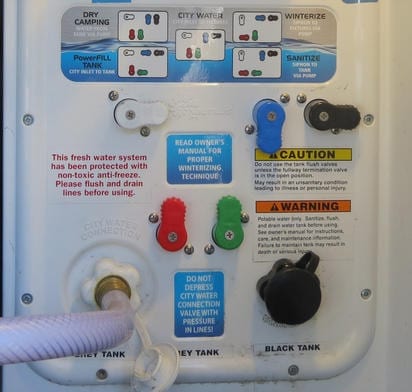

RV Holding Tank Sizes
The size of RV holding tanks will vary greatly depending on the size of the RV. Truck campers and tiny travel trailers have the smallest holding tanks, while Class A motorhomes and large fifth wheels have the biggest holding tanks.
Fresh water holding tanks typically range from 20 to 100 gallons. Black tanks and gray water tanks have a similar size range with capacities anywhere from under 10 gallons to up to 100 gallons.
To find the size of your RV holding tanks, check your owner’s manual or the manufacturer’s website. Keep in mind, some RVs have multiple black and gray tanks, so you should know the size of each tank.
RV Holding Tank Maintenance
Follow these best practices to keep your RV holding tanks clean and functioning.
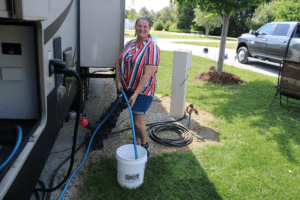

Flush Tanks Frequently
The most important aspect of maintaining your RV holding tanks is regularly flushing the tanks. Every time you dump the black tank, you should also flush the tank by filling it up with water and dumping again until no waste is left in the tank.
Use the Right Toilet Paper
Another way to keep your RV black tank in good condition is using the right toilet paper. Only single-ply toilet paper that easily dissolves in water should be used in an RV. Click here to see our pick for the best RV toilet paper.
Treat the Holding Tanks
After dumping always use a holding tank treatment, such as Camco TST MAX Drop-Ins. These black tank treatments help break down waste and toilet paper to prevent clogs. Most treatment tabs are also scented to help control septic odors in your RV.
Lubricate Tank Valves
The handles for RV holding tanks need to be lubricated. If they are not properly lubricated, the handles can stick and your tanks can get stuck in the open position. To prevent sticky handles, lubricate them regularly.
First, empty all of your holding tanks. Then, pull one handle out and spray Teflon lubricant on the metal rod. Slowly pull the lubricated handle in and out a few times. Repeat for the other tanks. Always pull the handles straight out, twisting can damage the connected cables.
Sanitize the Fresh Water Tank
Finally, the fresh water tank needs to be sanitized regularly. RV owners should sanitize their tank with bleach after storage or contamination. Read our step-by-step guide to cleaning an RV fresh water tank for more information.
RV Holding Tank FAQs
When should I dump my RV holding tanks?
Dump your RV gray and black tanks when the sensors located in the RV indicate that the tanks are full. When you first start RVing, you can wait for the gray water to start backing up into the sink or shower, then compare your sensor reading to determine the reading on your sensor when the tank is actually full.
Should I leave my RV gray tank open?
No. Both the gray and black tank valves on your RV should be kept closed until they are full or ready to be dumped. Open and empty the black tank first so the gray water can be used to clean waste out of the sewer hose.
Should the water pump in my RV be turned on?
RV water pumps should only be turned on when you are dry camping and using water in your fresh water tank. If you are hooked up to city water or RV park water, the water pump should be turned off?
How to tell if black tank is full in an RV?
Most RV black tanks have sensors and a panel that indicates when the black tank is full. These sensors are not always accurate, so it is best to err on the side of caution and dump anytime your believe the tank is full. If the black tank fills completely you will be able to see/smell build up when flushing the toilet.
What happens when the gray water tank is full in an RV?
If the gray water tank is completely full, water will start to back up in the sink and the shower. If water is not draining from your RV kitchen or bathroom sink, your gray tank probably needs to be emptied.
What is the capacity of RV holding tanks?
The capacity varies in different makes and models of RVs. Modern fifth wheels and large travel trailers typically have at least 60 gallon fresh water tanks and 45 gallon gray and black water tanks. Class A RVs will typically have slightly larger tanks.
If you have any other questions about your RV holding tanks, please leave them in the comments section below.
For more step-by-step RV maintenance guides, check out our eBook: The Owner’s Guide to RV Maintenance.
Happy dumping!


Christina Pate is a seasoned full-time RVer who, along with her husband Justin, has journeyed across the US, Canada, and Mexico. Drawing from her extensive travels, RV repairs and RV renovations, she founded Travels with Ted to guide and inspire fellow RV enthusiasts. Christina is also the co-author of The Owner’s Guide to RV Maintenance and the creator of My RV Log Book.

